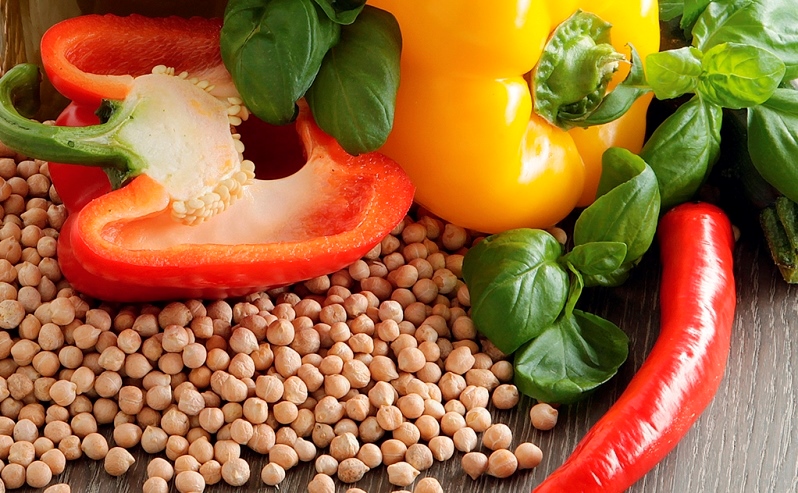Fibre is important – but why? We now know that it has many positive effects on the gastrointestinal tract and on the entire body.
Fibre is only found in plants where, for example, the fibres fulfil structural functions or serve as storage substances. A lot of fibre is found in the skin or husk which is why whole grain products, including oats, are particularly rich in fibre. Fibre is divided into two groups of so-called soluble and insoluble fibre due to its different characteristics. Sources of soluble fibre include vegetables, fruit and pulses, and insoluble fibre can be found in whole grain products, nuts and pulses. We can imagine fibre as predominantly indigestible sugar-like chains which travel through the stomach and small intestine and are then partially digested in the large intestine by naturally-occurring intestinal bacteria.
The effects of fibre:
- In the mouth it stimulates increased chewing which promotes digestion.
- It delays the emptying of the stomach and encourages a feeling of being sated.
- In the small intestine it can absorb substances such as heavy metals, bile acids and minerals and can reduce their absorption into the body. This is predominantly positive and no problem for the body as fibre-rich foods also provide lots of minerals.
- Through the uptake of water, the volume of the fibre increases significantly. This accelerates the transportation of food in the large intestine in particular.
- In the large intestine soluble fibre serves as nourishment for bacteria. Substances created from this promote the health of the bowel and soften stools. The amount of fibre in the diet should, by the way, be increased slowly so that the bowel can adjust to it and to avoid flatulence.
Clinical studies show that high consumption of fibre can reduce the risk of developing diseases. A lot of research has been carried out on its protective impact against cancer of the large intestine as well as investigations into protection against becoming overweight, high blood pressure and coronary heart diseases. In addition, a fibre-rich diet with many whole grain products has a positive effect on the level of cholesterol and can reduce the risk of developing diabetes.
If you are already suffering from cancer, it is healthy to eat an ample proportion of fibre unless otherwise advised by your doctor. During therapy it is important to differentiate, for example, in the case of side effects and weight loss. Here are two examples:
- Diarrhoea or constipation may occur during therapy. In both cases specific types of fibre can be helpful, for example, as found in psyllium seeds. On the one hand this type of fibre promotes bowel activity and softens the stool. On the other hand it absorbs water which can thicken extremely thin stools. The latter is also true of pectins which is why cooked carrots, grated apple and also bananas are recommended for diarrhoea, whereas many of the other sources of fibre should be avoided when having diarrhoea.
- If you suffer from a loss of appetite and/or weight loss, the focus is frequently placed on eating enough energy and protein which is often accompanied by a lower quantity of fibre. (For further information on the topic malnourishment I would like to recommend the TZM Nutrition and Cancer Work Group to you.)
If you have gained weight during therapy, by contrast, a fibre-rich diet with its satiating effect can be helpful in counteracting the unwanted weight gain.
The Deutsche Gesellschaft für Ernährung (German Nutrition Society) recommends an intake of 30 g of fibre per day due to its numerous positive effects. This quantity can be achieved through the use of:
- more whole grain products and less finely ground flours e.g. Type 1050 (very strong or hard/brown flour) instead of Type 405 (soft/patent flour),
- 3 portions of vegetables each day.
- 2 portions of fruit each day, and
- Pulses 1-2 times per week (lentils, chick peas, kidney beans,…)
Even simply replacing white flour with wholemeal flour more than doubles the amount of fibre. You can also choose a finely ground wholegrain bread which is often easier to digest. It is important to always make sure that “wholegrain” is stated on the ingredients list as a dark colour can also be achieved using additives. Since fibre absorbs water and that a number of its effects develop from this, it is important to ensure you drink enough water. The normal volume of water to drink is 1.5 to 2 litres per day.
If you would like to have more fibre in your food, I’d like to recommend the recipe in this blog from last week: “Kidney bean wraps – with avocado purée and vegetable strips“.

Pingback: Nachhaltigkeit in der Ernährung – Auswirkungen auf Gesundheit, Umwelt und vieles mehr | DER MENSCH IST, WAS ER ISST! | DER MENSCH IST, WAS ER ISST!
Pingback: Sustainability in nutrition – effects on health, the environment and even more | YOU ARE WHAT YOU EAT! | YOU ARE WHAT YOU EAT!
Pingback: Sausage, red meat and the uncertainty about cancer-promoting substances | YOU ARE WHAT YOU EAT! | YOU ARE WHAT YOU EAT!
Pingback: Brussel sprout gratin with potatoes and chicken breast | YOU ARE WHAT YOU EAT!